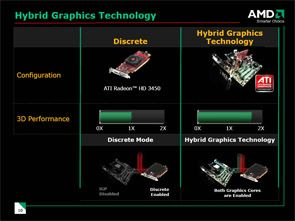AMD 780G Chipset and Athlon X2 4850e Preview
The Radeon HD 3200 IGP

AMD is branding the graphics processor inside the 780G as the Radeon HD 3200. Architecturally, the Radeon HD 3200 is virtually identical to AMD’s discrete Radeon HD 3450 configuration, also manufactured at 55nm and equipped with 40 stream processors. According to AMD, the principal differentiator is clock speed—the 780G runs at 500 MHz to the 3450’s 600 MHz. So what exactly are we saying there? In essence, 780G delivers the same DirectX 10 functionality you’d expect from one of AMD’s discrete cards. Whereas the Radeon HD 3450 has its own 64-bit memory interface attached to as much as 512MB of GDDR3, the 780G relies on a unified memory architecture. Some vendors, AMD says, will connect a display cache to the northbridge, enabling a slight performance boost. The Gigabyte board we’re working with, however, lacks that feature.


The Radeon HD 3200 graphics core is surprisingly robust. On top of its advanced 3D engine, the chipset also includes two independent display controllers, letting you run a dual-monitor configuration right out of the box. Our Gigabyte GA-MA78GM-S2H featured one 15-pin VGA output, a DVI output, and an HDMI output, for instance. The integrated core also boasts a revamped UVD block able to accelerate MPEG-2, H.264 and VC1 decoding. In previous versions of AMD’s UVD, MPEG-2 was handled by the GPU’s programmable shaders. Radeon HD 3200 sports dedicated circuitry to help minimize host processor utilization during MPEG-2 playback.
Now here’s where things get really cool for the value gamer. On its own, integrated graphics—even AMD’s Radeon HD 3200—might be considered insufficient for the latest, most demanding titles. But when you match AMD’s platform up to the Windows Vista operating system, you suddenly get support for Hybrid Graphics, a technology that uses the onboard Radeon HD 3200 GPU and a discrete board to achieve dramatically better performance. Hybrid Graphics relies on AFR to help divide the processing workload, so you’re best off with a discrete board evenly matched to the integrated core logic - faster cards will just be slowed down by the IGP. Pick up a Radeon HD 3450 online for $50 bucks and you’re good to go. Just be sure you’re running on Vista since Hybrid Graphics is not supported under XP.
Not only does that second card open the door to better frame rates in the latest games, but it’s also a first-class ticket to acres of desktop real estate. You see, the Radeon HD 3200 has a pair of independent display controllers. The Radeon HD 3450 does as well. Put them together and you have enough outputs for a quartet of monitors with the horsepower to drive Vista’s Aero. The $500 Quadro NVS 440 sitting in my desktop workstation now fears for its life.
Pro tip: When you drop a Radeon HD 3450 card into a 780G-based motherboard, you’ll have those four display outputs from which to choose when you attach a monitor. Use the motherboard’s connectors. As the platform sits idle, AMD says it’ll power down the discrete card, offering even greater energy savings. Plugging in a monitor to the discreet card keeps the card running and power flowing.
Four PCIe 2.0 lanes connect the feature-laden 780G to AMD’s new SB700 southbridge. The I/O-oriented companion chip features 12 USB 2.0 ports, a pair of USB 1.0 ports, a PCI bus, six SATA 3 Gb/s ports with software RAID support, parallel ATA connectivity, and an HD Audio interface. Expect most motherboard vendors to add their own Gigabit Ethernet, audio codec, and FireWire chips to complement AMD’s southbridge. The SB700 isn’t an earth-shatteringly advanced chip by any stretch of the imagination, but it does keep AMD competitive with Intel’s stable of ICH9 offerings.








